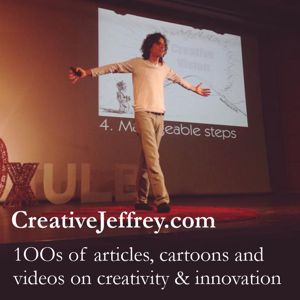Report 103
Your newsletter on applied creativity, imagination, ideas and innovation in business.
Wednesday 6 June 2012
Issue 210
Hello and welcome to another issue of Report 103, your twice-monthly (or thereabouts) newsletter on creativity, imagination, ideas and innovation in business.
As always, if you have news about creativity, imagination, ideas, or innovation please feel free to forward it to me for potential inclusion in Report103. Your comments and feedback are also always welcome.
Information on unsubscribing, archives, reprinting articles, etc can be found at the end of this newsletter.
Note
Most articles in this issue of Report 103 can also be found in the archives together with dozens more articles, papers and thoughts.
In this issue of Report 103
- Turn Your Problem into Goals
- Let's Bounce a Few Ideas off Each Other
- Has Innovation Lost its Meaning?
Also some self promotional stuff about anticonventional thinking....
INTERACT WITH JEFFREY
I am on the social networks and would love to connect with you there.
Facebook
Join me on my professional
page on Facebook –
LinkedIn
You can also connect
with me on LinkedIn.
Twitter
And you can follow me on Twitter.
I’m @creativejeffrey
Turn Your Problems Into Goals
By Jeffrey Baumgartner
Following my experiences in presenting anticonventional thinking (ACT), facilitating ACT sessions and providing workshops on how to use it, I am now working on an ACT 2.0 paper describing a newer improved methodology. The theory and the steps remain basically the same, but as with all new methods, we quickly discover ways to make them even better. Just as important, I have learned that terms used to describe aspects of the process are critical to its understanding.
One of my concerns with ACT from the beginning has been with the use of the word to describe the starting point. Creative problem solving (CPS) describe starting from a problem, of course. I have seen have often used the word “challenge”, as do many others. In ACT 1.0, I used the word “issue”, but that did not work so well.
Not Problems, Goals
If you stop and think about it, people more often use creativity to find a means of achieving a goal rather than solve a problem. The author does not see herself as bearing the problem of having written insufficient books, rather, she has the goal of writing another book. A business may not lack products, but management may feel it should develop an exciting new product to liven up its line.
Moreover, any problem can be reiterated as a goal. Sales are down? Your goal, then, would be to increase sales. Your production line is inefficient? Then you want to improve the efficiency of your production line.
Why Goals Are Better than Problems
More importantly, I believe that there are important advantages to using the word “goal” as the aim of the creativity process. Firstly, translating a problem (if you are starting from a problem) into a goal encourages you to question the problem. This, in my experience, is where most people fail when trying to solve problems. They immediately try to come up with ideas rather than try to understand the problem properly.
Formulating goal statements from problems, makes you think about the problem and what aspect of it you actually wish to solve. If you say “we need to increase sales”, most people will immediately reply, “of course you do. Every business does! What do you want to do? Improve your sales process? Improve your marketing communications? Make your product more desirable?”
With these questions, you may realise that your goal is to generate more leads for your sales team. Or you might realise that your products are perceived as out of date by the young people you are trying to sell to, so you need to make your products more modern and ‘sexy’. Clearly, these two goals are very, very different! Yet either or both could be goals you need to strive for in order to achieve your overriding goal of selling more.
In addition, I believe that using creativity to achieve a goal is more positive and motivating than using it to solve a problem. Sure, it is essentially the same thing. But which challenge do you think most people would find more interesting?
“Our line of girls’ shoes is outdated and sales are falling. How can we solve this?”
- or -
“Let’s make our line of girls’ shoes trendy and exciting! How can we do this?”
Goals and Sub-goals
Working with goals instead of problems also makes it easier to divide big goals into smaller sub-goals which may become a part of the final solution. This can be important too. I find that when people come to me with problems that need solving, these problems are the result of multiple issues, each of which need to be addressed. However, at least to my mind, the notion of root-problems and sub-problems seems odd. Worse, it seems depressing!
Of course problems are still relevant to creative idea generation. If we face problems, in business or personally, that we wish to solve through creativity, it is still essential to deconstruct and analyse those problems. Formulating a goal statement is ultimately a reworking of a problem statement. Nevertheless, I believe that if we aim to focus creativity on attaining stated goals, we will get more interesting results. What do you think? What is your experience?
Anticonventional Thinking Workshops for Your Team
This year, I have given anticonventional thinking workshops in Europe and the USA and have been booked for more sessions in upcoming months. If you would like me to deliver an ACT workshop with your entire workforce, a business unit or a team, just let me know. I normally combine an explanation of the method together with exercises that enable your people to practice ACT on actual business goals.
I can also drop the explanation and focus on facilitating an anticonventional thinking session specifically to help you solve problems and achieve goaks.
In my sessions, the focus is on deconstructing the problem in order to understand it better and formulating goals and subgoals before generating ideas. Normally, it is during the problem deconstruction phase that I hear the most "ahas".
For more information, contact me using the form or telephone numbers here...
Let’s Bounce a Few Ideas Off Each Other
One of several aspects of creative thinking, that lead me to develop Anticonventional Thinking (ACT), is that the way a group of highly creative people naturally collaborate on idea development is very different to the approach you are supposed to take in brainstorming or using creative problem solving (CPS), which is a more elaborate and structured form of brainstorming. In brainstorming, of course, you are supposed to reserve judgement and welcome all ideas with the aim of producing a long list (or, often, a large number of sticky-notes) of ideas. Later, these ideas are reviewed critically in order to identify which ones to go further with. But criticism is forbidden until then.
However, in my experience as an artist and writer, when highly creative people want ideas for a project, they usually take a very different approach. They bounce ideas off each other with the aim of formulating a creative project (such as a script or a song) or contributing to a project that is in progress.
How Creatives Do It
For instance, imagine that you and I are bouncing ideas off each other for a film concept. The first thing we will do is look into our own minds for ideas. However, rather than simply shout out each idea, we think about it and decide whether or not it is interesting enough to propose. Ideas that are boring or uninteresting are not shared. And here is the first key difference between CPS and ACT: CPS states that you should keep no ideas to yourself and put everything you think of on the table, no matter how trivial or how bizarre. Most creative people do not want to waste their time with trivial or boring ideas – and so do not suggest them. However, they tend to embrace the unconventional and bizarre and so take pride in proposing such ideas. As a result, when highly creative people collaborate on developing ideas, they usually share far fewer than averagely creative brainstormers.
Back to our collaboration. Once I’ve suggested an idea, we both immediately consider it. If it might have potential, we develop it a bit. For instance, I suggest that we do a science fiction film about a private detective in the far future. You might immediately reject my idea saying that it is too much like X-Files and Men in Black. I can counter and explain why my idea is different to, and better than, those. This debate could go on for a while until we either agree to reject it or develop it more.
Developing an Idea with Further Ideas
In this case, we might now start thinking about the main character, the future that she inhabits and the kinds of crimes she investigates. Since we are both very creative, you can be sure there will be some wild ideas here. Nevertheless, in time we may find that we do not have sufficiently original ideas to turn this idea into a film. So, we set the idea aside, with at least one of us making notes about it in case we decide to explore the idea in the future. Then we think about ant suggest new ideas.
Perhaps you suggest a film, based on Romeo and Juliet, which takes place in a post-apocalyptic world. Once again, we work our way through a similar process.
Eventually, we will have a concept that we both agree upon. At this time, we can also agree on the next steps and who is responsible for each. We plan to meet again in a couple of days to compare notes and go further.
Here is another critical difference between brainstorming and the way highly creative people naturally collaborate. At the end of a brainstorm, we can expect to have a very large number of ideas that an individual or team will need to sift through in order to determine which idea or ideas merit further development. In the case of creative collaboration, we have a chosen idea and initial action to take.
You Do Not Need the Most Creative Idea; You Need an Actionable Idea Now
Brainstorming fans might argue that by not brainstorming every last possibility, we may have missed out on a more creative alternative. Frankly, I doubt this is the case. Moreover, I would further argue it does not matter. What matters is that we have a highly creative idea that we are already acting upon rather than a list of 50 ideas that needs to be reviewed.
As you can see, the artistic approach breaks just about every rule in brainstorming:
- Participants have purposely kept ideas to themselves – when the ideas are perceived as too conventional.
- Participants have criticised and debated each others’ ideas.
- Participants have made immediate judgements about ideas rather than reserving judgement for a later time.
Yet this approach, which I have incorporated into ACT is the approach highly creative people take when using creativity to solve problems or achieve goals. It is the approach I have usually taken myself and when working with others on creative projects.
Interestingly, I find that this is also a natural approach. If I suggest to another writer that we bounce ideas off each other to collaborate on a project, she will understand what I mean and we can get started immediately, without needing to put in place any brainstorming rules.
Where CPS Is Useful
Where does this leave CPS? I feel CPS is best when you need a large number of smaller, moderately creative ideas. For instance, once we have defined the basic concept of our film: the main characters, the key conflicts, the main settings, then we may want to brainstorm the details of our future scenarios (if we go with a science fiction film) because we would need a lot of ideas in order to create rich settings for our characters to live in. In this situation, a list of visual features in a futuristic landscape would be useful.
Yet, even when we “brainstorm” like this, evidence suggests that we will have more ideas and more creative ideas if we allow ourselves to criticise and debate ideas as they are proposed1.
So, when you want big, creative concepts, anticonventional thinking is the way to go. When you want a lot of smaller ideas, brainstorming (with modifications) is the way to go.
Footnote
- Matthew Feinberg, Charlan Nemeth (2008) “The ‘Rules’ of
Brainstorming: An Impediment to Creativity?” Institute for Research
on Labor and Employment Working Paper Series; University of California, Berkeley;
Paper iirwps-167-08 http://www.techrepublic.com/whitepapers/the-rules-of-brainstorming-an-impediment-to-creativity/2555083/post
(free registration required)
Anticonventional Coaching
Would you like to have me at your beck and call, providing suggestions on how to achieve goals through anticonventional thinking? I can provide you wish insight onj deconstructing problems, formulating goal statements, generating ideas and much, much more.
Has Innovation Lost Its Meaning?
I fear business innovation has moved from being (first) a business process seriously practised by a few businesses to (second) being an understood need in the world of business to (finally and currently) being a buzz-word that is in great danger of becoming a ridiculous and meaningless word.
A few days ago, I read an article that was supposedly about innovation – but seemed to me to be about market research. While I appreciate that the implementation of ideas that result from learnings from market research might be innovation. The market research is not – unless it is successfully done in a creative new way that generates value to the business. For instance, plugging people’s brains into computers in order to determine what they truly desire, as opposed to what they claim they desire, might be innovative (if it works). But traditional market research is not innovation. It is market research.
Innovation This Manager, Innovation That Manager
Today, I plugged the word “innovation” into a couple of Job Search web sites. I found jobs like “Innovation Engineer”, “Innovation Sales Executive”, “Innovation Technologist”, “Director Marketing Innovation” and so on. However, on looking at the prerequisites for these positions, the demands were typical of anyone holding the same position, but without the word “Innovation” in the title. For instance, the Director Marketing Innovation is required to have an MBA and marketing experience. Frankly, if I was looking for an innovative marketing person, I’d be looking for someone without an MBA and with diversified experience, at least half of which had nothing to do with marketing.
But let us face it, these positions have little to do with actual innovation and a lot to do with putting a buzz-word in the job title and claiming the hiring company is innovative. “By golly, we’ve got a Director Marketing Innovation, so we must be innovative!” and, indeed, putting a buzzword in a job title is far easier than actually changing the corporate culture to embrace innovation – an action which few companies have done, in spite of their excessive use of the word innovation.
Too Many Innovation Blogs
Likewise, some years ago Report 103 was one of the scant few web resources on innovation (it is often called ‘a blog’ but it’s not really). Today, there are gazillions of blogs, newsletters and twitterers writing about innovation. The result is an awful lot of noise and little of practical value. Indeed, few of these writers seem to have read much of the current research related to innovation and instead put forth a lot of assumptions about innovation.
A search on the word “innovation” in Amazon.com results in over 50,000 titles!
Innovation No Longer About Innovation?
That’s all wonderful. But the result is that innovation has stopped being innovative and has become little more than a meaningless buzzword. Indeed, it has reached the point that if you truly want your company to be innovative, the first thing you probably need to do is to ban the word “innovation”!
Then focus on things like striving the achieve your strategic vision through creativity; outdoing the competition by being uniquely better than them; aiming for as much diversity in your thinking, people and actions as possible; and change your world to make it a better place.
Then you can happily succeed (through true innovation) while your competitors wallow in their verbal innovation.
Read My Book and Save a Fortune on Consultants!
If you are setting up an innovation initiative in your company, take a look at my book, The Way of the Innovation Master, it will not only provide you with the information you need, but it will entertain you as well! Better still, with my knowledge in your hands, you won't need to hire expensive innovation consultants to help you get your innovation initiative up and running!
Read more at http://www.creativejeffrey.com/books/index.php
ARCHIVES
You can find this and every issue of Report 103 ever written at our archives.
Happy thinking!
Report 103 is a complimentary eJournal from Bwiti bvba of Belgium (a jpb.com company: http://www.creativejeffrey.com). Archives and subscription information can be found at http://www.creativejeffrey.com/report103/
Report 103 is edited by Jeffrey Baumgartner and is published on a monthly basis.
You may forward this copy of Report 103 to anyone, provided you forward it in its entirety and do not edit it in any way. If you wish to reprint only a part of Report 103, please contact Jeffrey Baumgartner.
Contributions and press releases are welcome. Please contact Jeffrey in the first instance.




